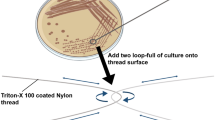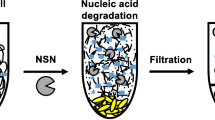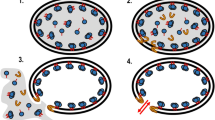Abstract
Objectives
Metal-ion independent non-specific nucleases are of high potential for applications in EDTA-containing bioprocessing workflows.
Results
A novel extracellular non-specific nuclease EcNuc from the enterobacterium Escherichia coli has been identified. The recombinant gene was expressed and the protein was purified. Maximum activity of the enzyme was detected at 41.7 °C and at an acidic pH of 5.8. EcNuc tolerates EDTA in the reaction buffer at concentrations of up to 20 mM and the activity is not impaired by high concentrations of mono- and divalent metal ions in the absence of EDTA. The viscosity of crude protein extracts after cell lysis in EDTA-containing buffers is reduced when supplemented with EcNuc.
Conclusion
Proof-of-concept has been demonstrated that a metal-ion independent non-specific nuclease can be applied for removal of nucleic acids in EDTA-containing buffers for the subsequent purification of proteins from crude extracts.



Similar content being viewed by others
References
Bao Y, Higgins L, Zhang P, Chan SH, Laget S, Sweeney S, Lunnen K, Xu SY (2008) Expression and purification of BmrI restriction endonuclease and its N-terminal cleavage domain variants. Protein Expr Purif 58:42–52
Beck BD, Arscott PG, Jacobson A (1978) Novel properties of bacterial elongation factor Tu. Proc Natl Acad Sci USA 75:1250–1254
Belkebir A, Azeddoug H (2012) Characterization of LlaKI, a new metal ion-independent restriction endonuclease from Lactococcus lactis KLDS4. ISRN Biochem 2012:287230
Benedik MJ, Strych U (1998) Serratia marcescens and its extracellular nuclease. FEMS Microbiol Lett 165:1–13
Brown A, Horobin A, Blount DG, Hill PJ, English J, Rich A, Williams PM, Pritchard DI (2012) Blow fly Lucilia sericata nuclease digests DNA associated with wound slough/eschar and with Pseudomonas aeruginosa biofilm. Med Vet Entomol 26:432–439
Dang G, Cao J, Cui Y, Song N, Chen L, Pang H, Liu S (2016) Characterization of Rv0888, a novel extracellular nuclease from Mycobacterium tuberculosis. Sci Rep 6:19033
Eaves GN, Jeffries CD (1963) Isolation and properties of an exocellular nuclease of Serratia marcescens. J Bacteriol 85:273–278
Liao C, Liu M, Bai X, Liu P, Wang X, Li T, Tang B, Gao H, Sun Q, Liu X, Zhao Y, Wang F, Wu X, Boireau P, Liu X (2014) Characterisation of a plancitoxin-1-like DNase II gene in Trichinella spiralis. PLoS Negl Trop Dis 8:e3097
MacLellan SR, Forsberg CW (2001) Properties of the major non-specific endonuclease from the strict anaerobe Fibrobacter succinogenes and evidence for disulfide bond formation in vivo. Microbiology 147:315–323
Motulsky H (2016) GraphPad Curve Fitting Guide. http://www.graphpad.com/guides/prism/7/curve-fitting/index.htm. Accessed 25 September 2018
Pommer AJ, Wallis R, Moore GR, James R, Kleanthous C (1998) Enzymological characterization of the nuclease domain from the bacterial toxin colicin E9 from Escherichia coli. Biochem J 334(Pt 2):387–392
Rangarajan ES, Shankar V (2001) Sugar non-specific endonucleases. FEMS Microbiol Rev 25:583–613
Rudolph AE, Stuckey JA, Zhao Y, Matthews HR, Patton WA, Moss J, Dixon JE (1999) Expression, characterization, and mutagenesis of the Yersinia pestis murine toxin, a phospholipase D superfamily member. J Biol Chem 274:11824–11831
Song Q, Zhang X (2008) Characterization of a novel non-specific nuclease from thermophilic bacteriophage GBSV1. BMC Biotechnol 8:43
Stuckey JA, Dixon JE (1999) Crystal structure of a phospholipase D family member. Nat Struct Biol 6:278–284
Vassylyeva MN, Klyuyev S, Vassylyev AD, Wesson H, Zhang Z, Renfrow MB, Wang H, Higgins NP, Chow LT, Vassylyev DG (2017) Efficient, ultra-high-affinity chromatography in a one-step purification of complex proteins. Proc Natl Acad Sci USA 114:E5138–E5147
Wang D, Miyazono KI, Tanokura M (2016) Tetrameric structure of the restriction DNA glycosylase RPabI in complex with nonspecific double-stranded DNA. Sci Rep 6:35197
Yang W (2011) Nucleases: diversity of structure, function and mechanism. Q Rev Biophys 44:1–93
Acknowledgements
We thank Stefan Edelburg for the help with the VICTOR™ X4 Multilabel Plate Reader.
Supporting information
Supplementary Figure 1—Codon usage optimized nucleotide sequence of EcNuc without predicted signal peptide. The deduced amino acid sequence is indicated below in 1-letter amino acid code.
Supplementary Table 1—Purification of recombinant EcNuc after expression in E. coli Veggie BL21 (DE3).
Author information
Authors and Affiliations
Corresponding author
Electronic supplementary material
Below is the link to the electronic supplementary material.
Rights and permissions
About this article
Cite this article
Schmitz, S., Nölle, V. & Elleuche, S. A non-specific nucleolytic enzyme and its application potential in EDTA-containing buffer solutions. Biotechnol Lett 41, 129–136 (2019). https://doi.org/10.1007/s10529-018-2618-0
Received:
Accepted:
Published:
Issue Date:
DOI: https://doi.org/10.1007/s10529-018-2618-0




